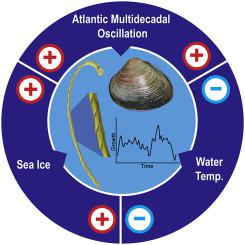Estuarine, Coastal and Shelf Science ( IF 2.6 ) Pub Date : 2020-07-14 , DOI: 10.1016/j.ecss.2020.106892 Michael L. Carroll , Madelyn J. Mette , William G. Ambrose

|
Long time series are necessary to separate natural variability from that due to climate change and make it possible to interpret the impact of environmental change on ecosystems. Sclerochronological analysis of environmental records in the shells of mollusks make it possible to reconstruct environmental-ecological linkages over sufficiently long time scales to detect ecosystem change. Annually resolved archives can be key indicators of how climate change manifests in the marine ecosystem and are especially important in areas with limited instrumental records. We developed a master growth chronology of the Greenland Cockle (Serripes groenlandicus) from Bear Island (Bjørnøya), Svalbard, Norway (74°41′N, 18°56′E) from analysis of annual shell growth increments. The chronology was developed from 13 individuals collected from 80 m deep and ranging in age from 40 to 48 years old (the oldest known individuals of this species to date). The master chronology, expressed as a growth index (GI), extended from 1968 to 2012 and exhibited a cyclical pattern with decadal periods of high growth alternating with slower growth intervals. We identified significant relationships between variations in large-scale climate regimes (e.g. Atlantic Multidecadal Oscillation), local environmental conditions (e.g., sea temperature, sea ice), and shell growth. A model using sea temperature and sea ice explained 34–49% of the annual variations in shell growth patterns. The growth chronology and environmental linkages for cockles at this site in southern Svalbard near the southern extent of Arctic water in the Barents Sea were substantially different than at other locations in Svalbard. We conclude that the Greenland Cockle is quite sensitive to environmental changes over annual to decadal scales and therefore can serve as a proxy of climate change effects on ecosystem processes in the Arctic, but that local environmental processes that regulate food availability to the seabed are key determinants of environmental regulation on shell growth.
中文翻译:

来自斯瓦尔巴特群岛比约恩(Bjørnøya)(熊岛)的格陵兰鸟蛤(Serripes groenlandicus Mohr 1786)创纪录的环境变化:地方和区域增长动力
需要较长的时间序列来将自然变异性与气候变化引起的变异性区分开来,并有可能解释环境变化对生态系统的影响。软体动物壳内环境记录的年代记述分析可以在足够长的时间内重建环境生态联系,以检测生态系统的变化。每年解析的档案可以作为气候变化如何在海洋生态系统中体现的关键指标,在仪器记录有限的地区尤其重要。我们开发了格陵兰鸟蛤(Serripes groenlandicus),是通过分析每年的贝壳生长增量得出的,来自挪威斯瓦尔巴特群岛的比熊岛(Bjørnøya)(74°41′N,18°56′E)。年表是从13个个体中发展而来的,这些个体从80 m深处收集,年龄从40到48岁不等(迄今为止,该物种最古老的个体)。主年代表以增长指数(GI)表示,从1968年扩展到2012年,并呈现出周期性的模式,即高增长的十年期与较慢的增长间隔交替出现。我们确定了大规模气候制度(例如大西洋多年代际涛动)变化,当地环境条件(例如海水温度,海冰)和壳生长之间的显着关系。使用海水和海冰的模型解释了壳生长模式每年变化的34%至49%。在巴伦支海北极水南部南部附近的斯瓦尔巴特群岛南部,该地区鸟蛤的生长时间和环境联系与斯瓦尔巴特群岛其他地区的鸟蛤的生长时间和环境联系有很大不同。我们得出的结论是,格陵兰鸟蛤对年际到十年尺度的环境变化非常敏感,因此可以作为气候变化对北极生态系统过程影响的替代指标,但是调节海底食物可得性的当地环境过程是关键因素环境对壳生长的影响。











































 京公网安备 11010802027423号
京公网安备 11010802027423号